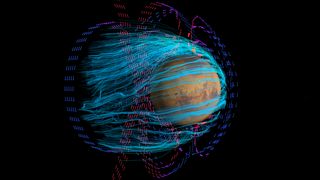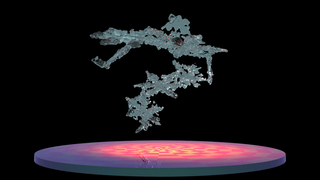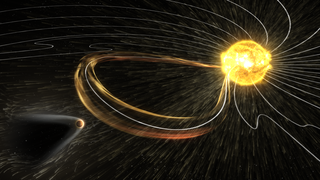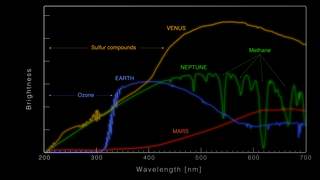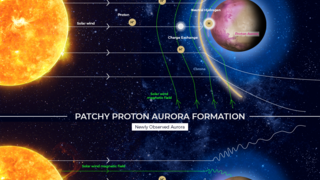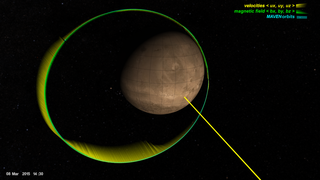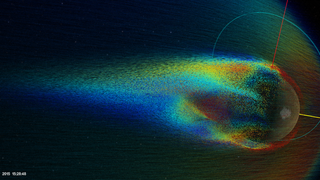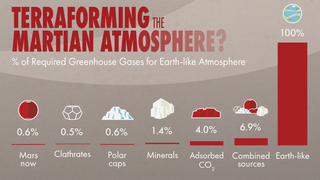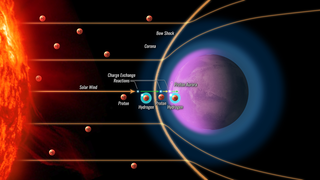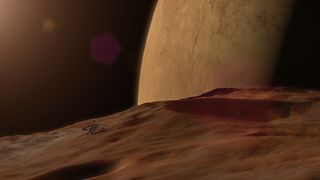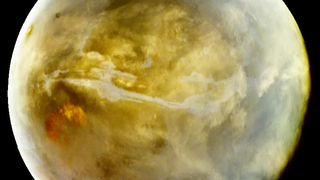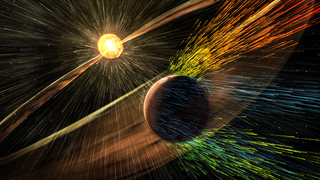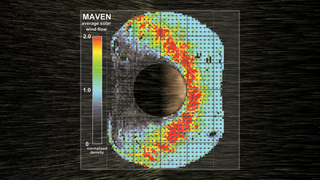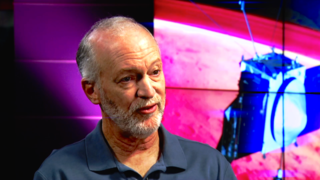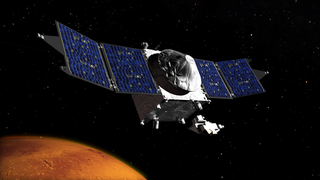Planets and Moons
ID: 4370
Today, Mars is a global desert with an atmosphere far too thin to support bodies of flowing water, but evidence shows that Mars was considerably wetter in the ancient past. Scientists think that climate change on Mars was caused by the loss of an early, thick atmosphere, and NASA’s MAVEN mission is investigating whether it was driven into space.
One of the prime suspects is the solar wind, a stream of electrically charged particles continuously blowing outward from the Sun. Unlike Earth, Mars lacks a global magnetic field to deflect the incoming solar wind. Instead, charged particles from the Sun crash into the Mars upper atmosphere, and can accelerate Martian ions into space. Now, MAVEN has observed this process in action – by measuring the velocity of ions escaping from Mars.
The movies on this page compare simulations of ion escape with MAVEN’s observations of oxygen ion flux. The results closely fit the expected pattern, with the most energetic ions (in red) accelerated in a plume above Mars, while the majority of escaping ions (green) are lost along the “tail” region in the wake of the solar wind. MAVEN’s observations confirm that the solar wind is a significant contributor to atmosphere loss on Mars, and they bring scientists closer to solving the mystery of the ancient Martian climate. Read the full press release about this finding.
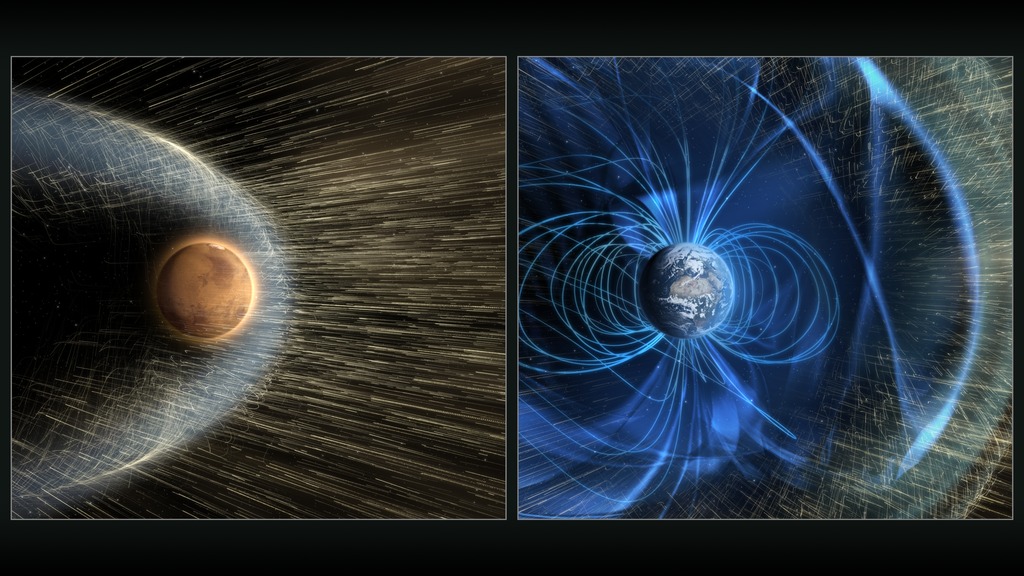
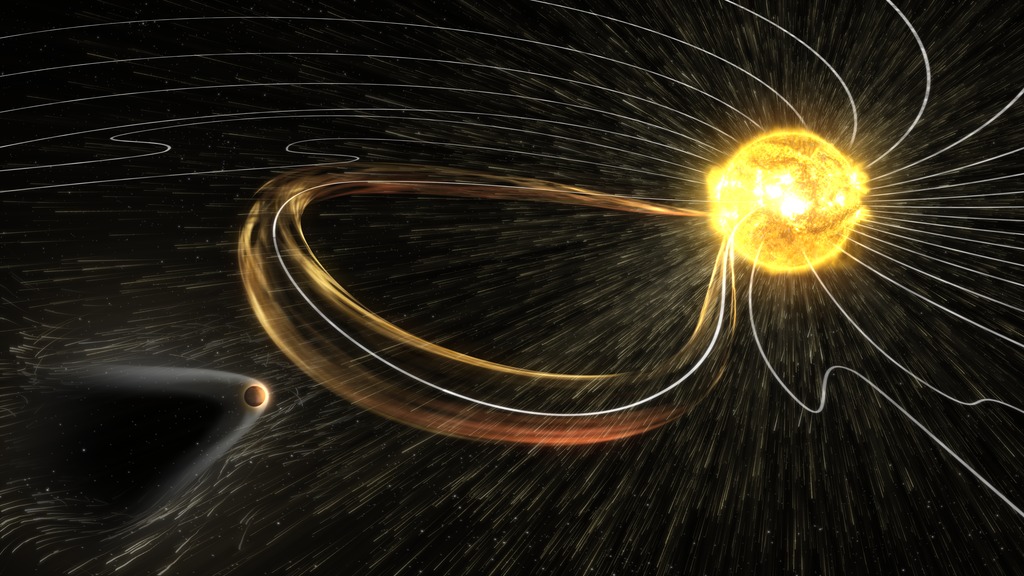
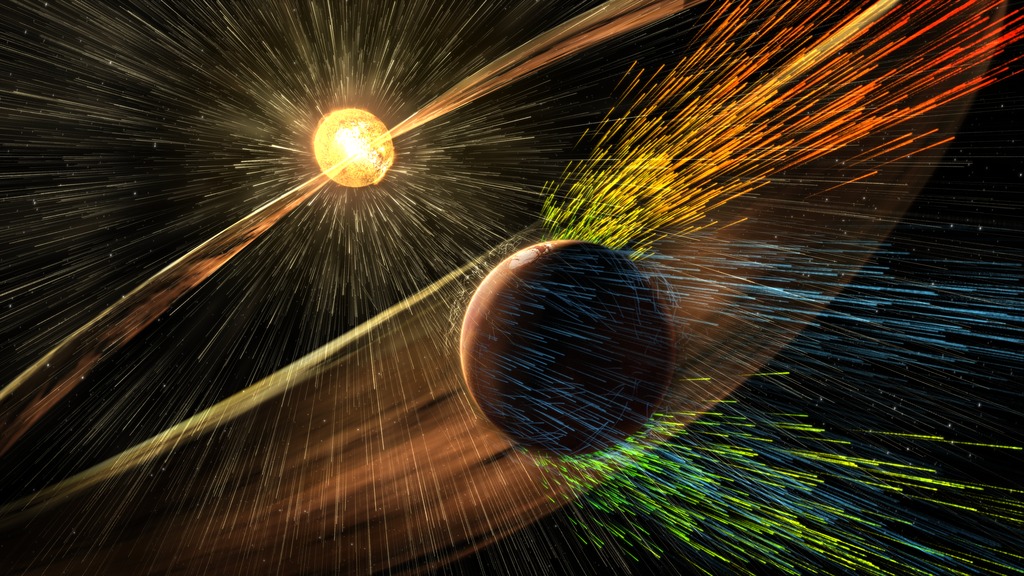
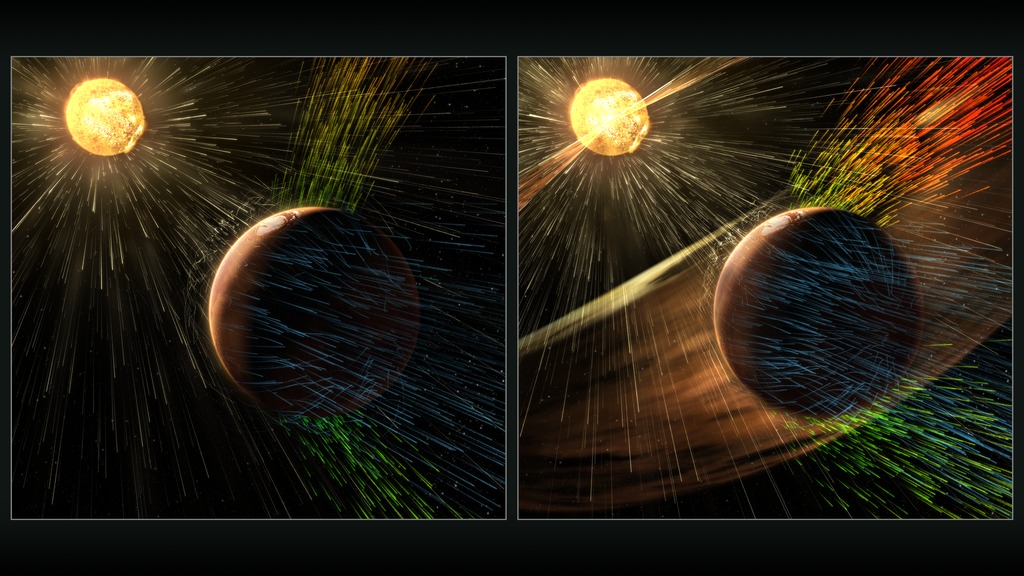
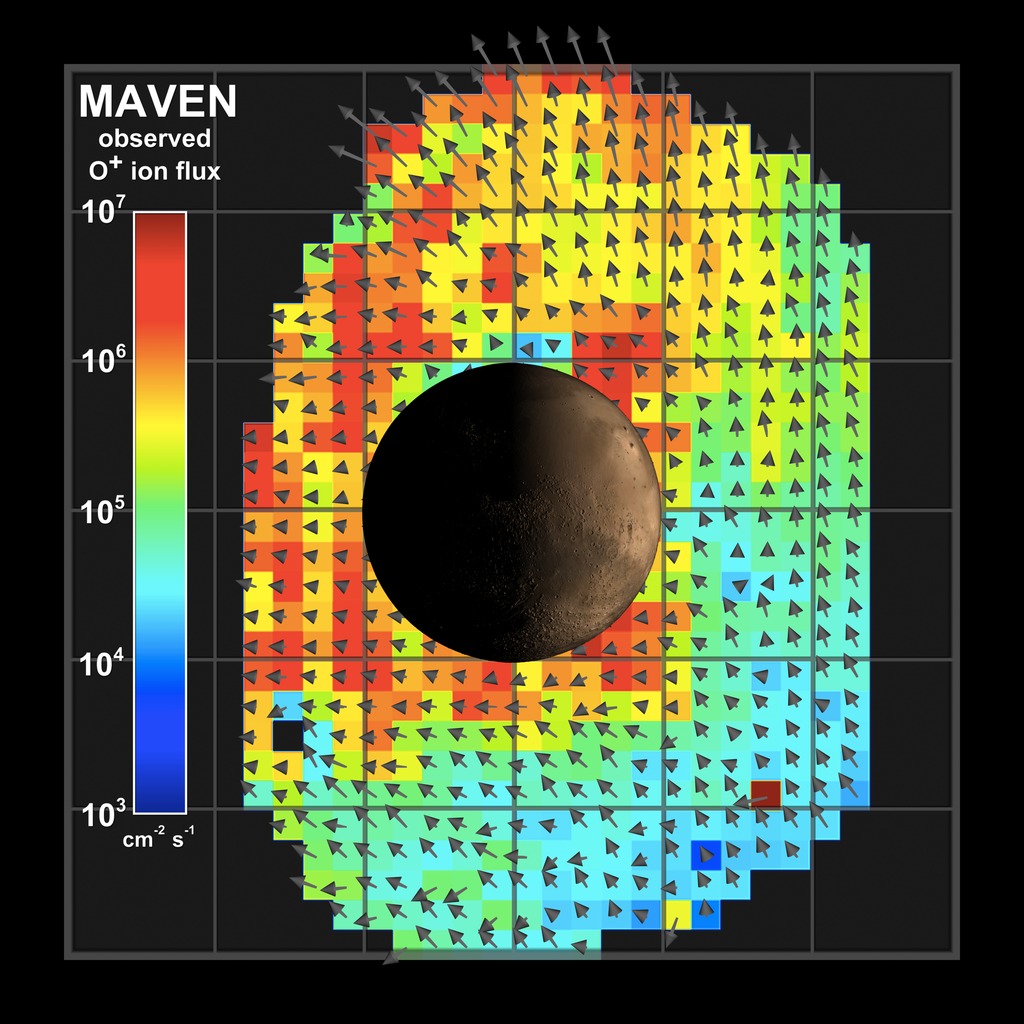
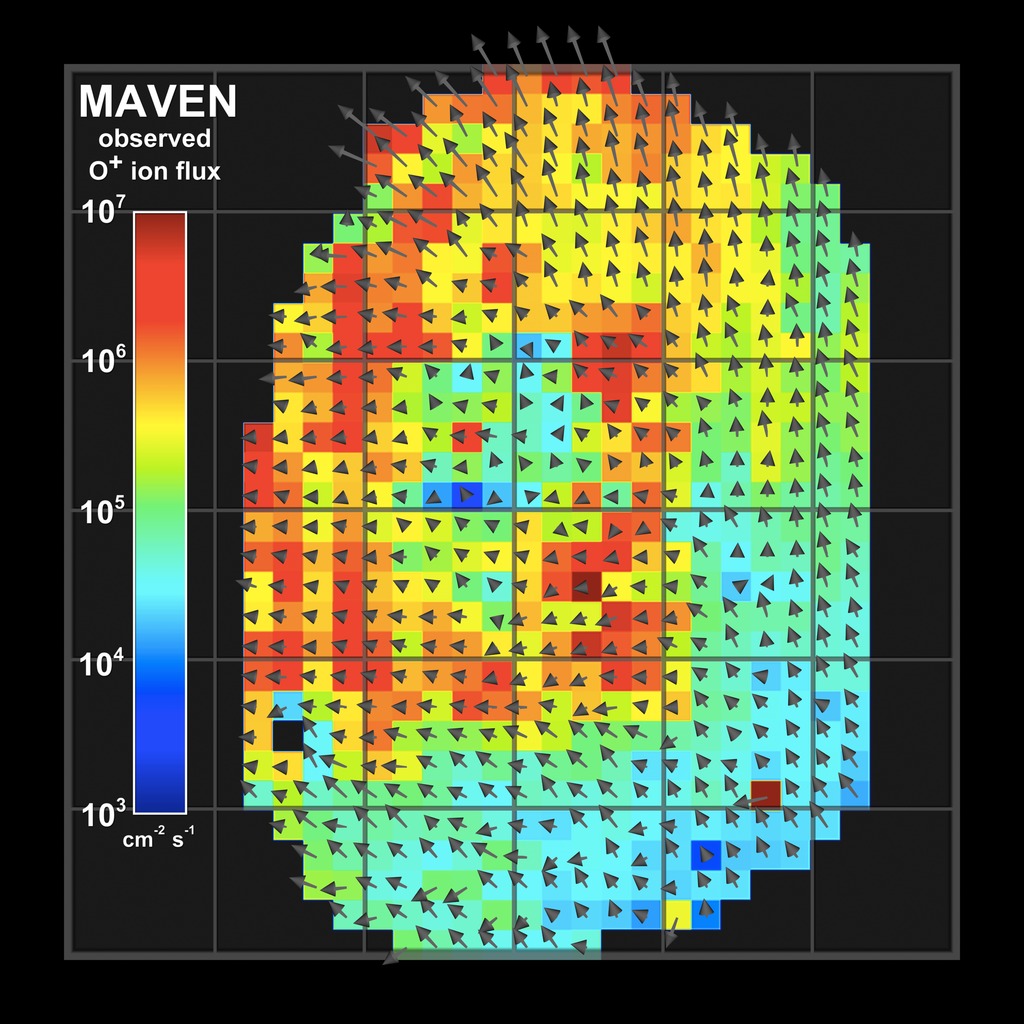
Solar Wind Strips the Martian Atmosphere
One of the prime suspects is the solar wind, a stream of electrically charged particles continuously blowing outward from the Sun. Unlike Earth, Mars lacks a global magnetic field to deflect the incoming solar wind. Instead, charged particles from the Sun crash into the Mars upper atmosphere, and can accelerate Martian ions into space. Now, MAVEN has observed this process in action – by measuring the velocity of ions escaping from Mars.
The movies on this page compare simulations of ion escape with MAVEN’s observations of oxygen ion flux. The results closely fit the expected pattern, with the most energetic ions (in red) accelerated in a plume above Mars, while the majority of escaping ions (green) are lost along the “tail” region in the wake of the solar wind. MAVEN’s observations confirm that the solar wind is a significant contributor to atmosphere loss on Mars, and they bring scientists closer to solving the mystery of the ancient Martian climate. Read the full press release about this finding.






Used Elsewhere In
Source Material
Related
For More Information
Visualization Credits
Greg Shirah (NASA/GSFC):
Lead Visualizer
Horace Mitchell (NASA/GSFC):
Visualizer
Ernie Wright (USRA):
Visualizer
Dan Gallagher (USRA):
Producer
Editor
Bruce Jakosky (LASP):
Scientist
Xiaohua Fang (LASP):
Scientist
Yaxue Dong (LASP):
Scientist
Yingjuan Ma (UCLA):
Scientist
Joy Ng (USRA):
Narrator
Michael Lentz (USRA):
Animator
Brian Monroe (USRA):
Animator
Lead Visualizer
Horace Mitchell (NASA/GSFC):
Visualizer
Ernie Wright (USRA):
Visualizer
Dan Gallagher (USRA):
Producer
Editor
Bruce Jakosky (LASP):
Scientist
Xiaohua Fang (LASP):
Scientist
Yaxue Dong (LASP):
Scientist
Yingjuan Ma (UCLA):
Scientist
Joy Ng (USRA):
Narrator
Michael Lentz (USRA):
Animator
Brian Monroe (USRA):
Animator
Please give credit for this item to:
NASA's Scientific Visualization Studio and the MAVEN Science Team
NASA's Scientific Visualization Studio and the MAVEN Science Team
Short URL to share this page:
https://svs.gsfc.nasa.gov/4370
Missions:
Mars Global Surveyor - MGS
MAVEN: Mars Atmosphere and Volatile EvolutioN
Data Used:
Note: While we identify the data sets used in these visualizations, we do not store any further details nor the data sets themselves on our site.
This item is part of these series:
Narrated Movies
Flows
MAVEN Science Videos
MAVEN
Keywords:
SVS >> Climate
SVS >> HDTV
SVS >> Mars
SVS >> Hyperwall
SVS >> MAVEN
SVS >> Solar System >> Planets >> Mars >> Ionosphere
SVS >> Solar System >> Planets >> Mars >> Atmosphere
NASA Science >> Planets and Moons
GCMD >> Earth Science >> Sun-earth Interactions >> Ionosphere/Magnetosphere Dynamics >> Solar Wind
GCMD keywords can be found on the Internet with the following citation: Olsen, L.M., G. Major, K. Shein, J. Scialdone, S. Ritz, T. Stevens, M. Morahan, A. Aleman, R. Vogel, S. Leicester, H. Weir, M. Meaux, S. Grebas, C.Solomon, M. Holland, T. Northcutt, R. A. Restrepo, R. Bilodeau, 2013. NASA/Global Change Master Directory (GCMD) Earth Science Keywords. Version 8.0.0.0.0
https://svs.gsfc.nasa.gov/4370
Missions:
Mars Global Surveyor - MGS
MAVEN: Mars Atmosphere and Volatile EvolutioN
Data Used:
BATS-R-US Magnetosphere Model
Model - Community Coordinated Modeling Center (CCMC)
MHD Magnetospheric simulation
MAVEN/STATIC/Ion Flux
Observed Data - LASP: University of Colorado BoulderMars Monte Carlo Pickup Ion Transport (MCPIT) Model
Model - LASPThis item is part of these series:
Narrated Movies
Flows
MAVEN Science Videos
MAVEN
Keywords:
SVS >> Climate
SVS >> HDTV
SVS >> Mars
SVS >> Hyperwall
SVS >> MAVEN
SVS >> Solar System >> Planets >> Mars >> Ionosphere
SVS >> Solar System >> Planets >> Mars >> Atmosphere
NASA Science >> Planets and Moons
GCMD >> Earth Science >> Sun-earth Interactions >> Ionosphere/Magnetosphere Dynamics >> Solar Wind
GCMD keywords can be found on the Internet with the following citation: Olsen, L.M., G. Major, K. Shein, J. Scialdone, S. Ritz, T. Stevens, M. Morahan, A. Aleman, R. Vogel, S. Leicester, H. Weir, M. Meaux, S. Grebas, C.Solomon, M. Holland, T. Northcutt, R. A. Restrepo, R. Bilodeau, 2013. NASA/Global Change Master Directory (GCMD) Earth Science Keywords. Version 8.0.0.0.0
